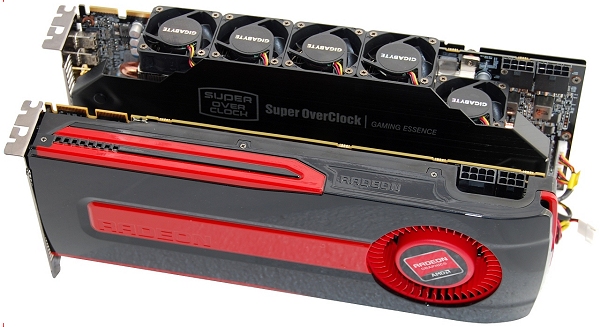Gigabyte Radeon HD 7970 SOC Review > Gigabyte's 7970 SOC in Detail
Gigabyte's 7970 SOC in Item
Along with the upgrades we just mentioned, Gigabyte has outfitted the card with a massive heatsink that occupies three expansion slots, forcing the fans to exist mounted on the side rather than on acme to avoid blocking a fourth slot. The heatsink measures 20cm long, 9cm wide and a staggering 4.5cm tall. When you lot include the vapor sleeping room and nine copper 6mm heatpipes, the menu weighs a whopping 3.5lbs (1.6kg).
The downside to this setup is that Gigabyte had to use five small 40mm high-speed fans to broadcast air over the enormous heatsink (this is marketed every bit its "WindForce 5X" pattern). These fans are configured to suck air through the heatsink using a pull rather than button organisation, which Gigabyte says is much more efficient for this blueprint.



The visitor also claims that despite using five tiny fans, its design is much cooler and quieter than AMD'south reference. Surprisingly, at x,000RPM the fans are said to generate just 53dBA of combined noise, while the single 80mm reference blower generates 62.2dBA at 5100RPM.
With overclocking being the sole purpose of this carte, Gigabyte gets things started with some factory increases. The GPU has been bumped from 925MHz to 1080MHz -- a decent heave, though we retrieve information technology should ship at a minimum of one.1GHz.


Perhaps more disappointing is the fact that the retention has been left alone at 5500MHz, so we don't expect to run across a huge difference between the HD 7970 SOC and the GHz Edition without some transmission overclocking. Farther aiding that endeavor is a pair of 8-pivot ability connectors, upgraded from the standard half-dozen-pin/8-pivot configuration.
Gigabyte has also equipped the HD 7970 SOC with another unique characteristic called "Extreme Dual BIOS," which lets you toggle betwixt your primary and secondary BIOS with the press of a push.

Extreme Dual BIOS contains two dissimilar BIOS chips designed for separate purposes. The standard (Blue) BIOS is for air-overclocking, while the secondary (Cherry-red) BIOS is intended for LN2 overclocking and is designed to avoid potential cold bug issues at extremely depression temperatures.

Connectivity is ane area in which the Hd 7970 isn't and so extreme, featuring the standard configuration of two Mini DisplayPorts, an HDMI port and a Dual Link DVI-I connector.
Source: https://www.techspot.com/review/555-gigabyte-radeon-hd-7970-soc/page2.html
Posted by: coxexcurce.blogspot.com


0 Response to "Gigabyte Radeon HD 7970 SOC Review > Gigabyte's 7970 SOC in Detail"
Post a Comment